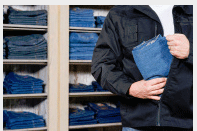 The shoplifting figures in the United States are nothing to laugh about. Billions of dollars are lost to shoplifters every year and the detrimental effect they have on business is serious. Loss prevention personnel are at risk every time they stop a shoplifter, and the solution to this problem has evaded the retail industry with costly consequences. Retailers spend millions of dollars in loss prevention systems, and studies show that these businesses benefit from the investment. The shoplifting is still there, but retailers are able to maintain and keep track of the inventory more easily. For more news about shoplifting, follow the links below.
The shoplifting figures in the United States are nothing to laugh about. Billions of dollars are lost to shoplifters every year and the detrimental effect they have on business is serious. Loss prevention personnel are at risk every time they stop a shoplifter, and the solution to this problem has evaded the retail industry with costly consequences. Retailers spend millions of dollars in loss prevention systems, and studies show that these businesses benefit from the investment. The shoplifting is still there, but retailers are able to maintain and keep track of the inventory more easily. For more news about shoplifting, follow the links below.
Shoplifters Costing Businesses Billions
GREENSBORO, N.C. — Shoplifting is a crime police say affects all types of businesses, and it’s costing a fortune.
WFMY News 2 went to several Triad businesses Friday. Owners at those businesses said shoplifters are crippling their day-to-day operations.
One Greensboro store manager said shoplifters cost his business anywhere from $10,000 to $15,000 each year.
“If somebody really wants to steal something, they’re going to steal it,” he said, “Ain’t nothing you can do about it.”
He’s frustrated, and he’s not alone.
Nationwide, shoplifters steal about $13 billion in merchandise every year, according to the National Association of Shoplifting Prevention. The same organization reports one in 11, or 27 million people in the U.S., are regular shoplifters.
KCSO shoplifting task force makes record number of arrests
KNOXVILLE — A Knox County Sheriff’s Office holiday shoplifting task force made a record number of arrests for 2014.
KCSO’s Safe Holiday Task Force made 372 arrests between Nov. 24 and Dec. 29, according to the Sheriff’s Office. The team was credited with 342 arrests during the same time period in 2013.
While the majority of the 2014 arrests were for shoplifting, they also included 35 felony theft charges, 12 DUI arrests and two fugitive captures.
The annual operation also recovered a record amount of stolen merchandise, totaling $65,614 worth of goods, and located two stolen vehicles. About $50,000 worth of stolen items were recovered in 2013.
Drug habit fuels shoplifting ring in Richmond and around Macomb County
A shoplifting ring has targeted Richmond stores for more than two years, according to a detective with the Richmond Police Department. Thieves steal easily marketable goods to fuel drug addictions, particularly heroin addiction, the detective said.
“What we have seen — and what our counterparts in Chesterfield and at the Macomb County Sheriff’s Department have seen — is a loose ring of individuals shoplifting certain high-priced items like Enfamil baby formula, Red Bull and Crest White Strips, and then either taking these directly to the drug house and trading them for drugs or selling them back-door to another store for cash to buy drugs,” said Det. Julia Frantz.






